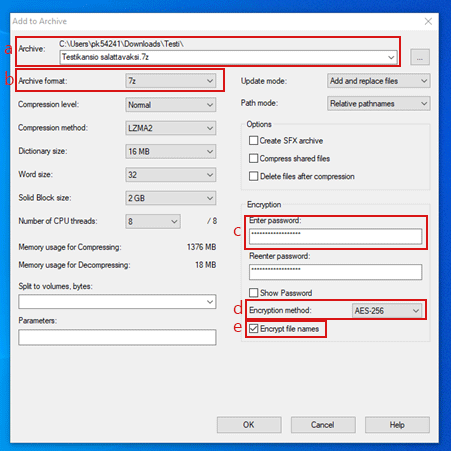Encrypting files
Encrypt confidential attachment files with a separate application before sending them via email. There are many apps you can use for encrypting files: 7-Zip, Veracrypt and Cryptomator. When used according to instructions, they all are good enough for encrypting also very sensitive files such as those containing special categories personal data (data class 1R). 7-Zip is easiest to use for simple use cases and that is why it is recommended.
More information about storing and encrypting files is available on the page Storing and processing research data.
A short example
In a research project, you need to transfer research data to a project member working at another organisation. You have ensured that you have the right to transfer the data and that the recipient can also process the data in the correct manner; also remember the log. On your encrypted (eg Bitlocker in TUNI Win computers) hard drive, you now you have a version of the data that is suitable for transfer in its own folder.
- Pack and encrypt the folder with the 7-Zip programme (format 7z, encryption method AES-256, recommended length of password at least 20 characters)
- Please note that the recipient must also have the 7-Zip programme to decode the encryption.
- Send the encrypted package to the recipient as an attachment to a secure Office 365 email or with Funet Filesender if the file is too large for email.
- Send the password required to open the file to the recipient with another medium, easiest via text message to the recipient's personal mobile number.
- PLEASE NOTE! Take special care to preserve the password to the encrypted file because it is not possible to open the package without it.
Step by step instructions
- The 7-Zip app is preinstalled in TUNI Windows computers. Open 7-Zip and find the encrypted material (File -> Open).
- Choose the folder or file and start packing/encrypting -> Add.
- Make the necessary choices (See the picture below.)
- Name the package in a manner that does not reveal its contents too much.
- Choose 7z as the format. Please note! The package can only be opened with the 7-Zip programme, meaning that the recipient must also have the programme.
- Add the password. The recommended length of the password is 20 characters including numbers and special characters.
- Choose AES-256 as the encryption method.
- Tick the box to encrypt the file names.

- When you approve the choices by clicking OK, the programme creates an encrypted package with the name you have chosen in the same folder as the original material.
- You can decrypt the encrypted 7z package, for example, by clicking the package with the right button of the mouse -> 7-Zip -> Extract Here.
- When prompted, give the password defined at encryption to decrypt the package.
IT Helpdesk
0294 520 500
it-helpdesk [at] tuni.fi (it-helpdesk[at]tuni[dot]fi)
helpdesk.tuni.fi